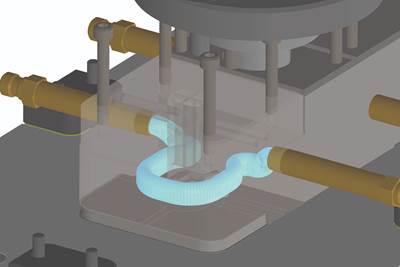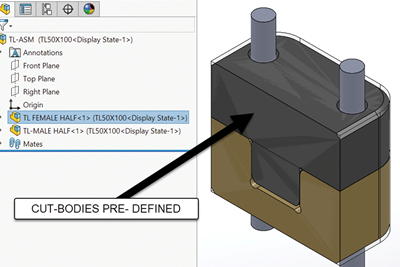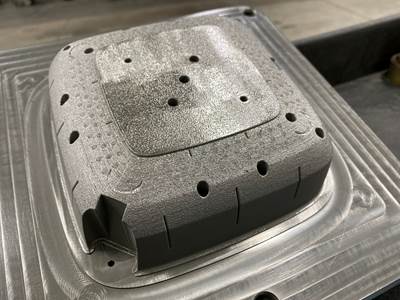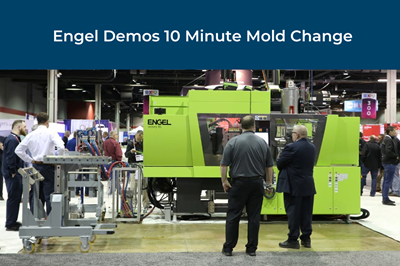Components of a Mold
Mold components are what make the mold work and the mechanisms used to deliver a quality end product. Key components include mold bases, pins, ejectors, lifters, bushings, guides and alignment devices. Mold components can be broken down into three categories: frame plates, frame components, and cavity tooling. Frame or base plates consist of the individual mold plates which can be seven plates in a stripper plate mold or even up to twenty plates or more, depending on the size and complexity. Frame components include all tooling that is within the frame that does not form the part. This includes guide or leader pins, bushings, return pins, interlocks, bolts, and seals. Tooling that may also be included in this category is ejector pins. Cavity tooling is the most critical and expensive tooling of a mold because it determines dimensional and aesthetic part features. It includes the cavities, cores, sleeves, and pins that directly form the part. Source

ESSENTIAL READING
VIEW ALLHow to Supply Cooling to Additive Tooling
Additive tooling provides limitless options for cooling a mold’s difficult-to-cool areas.
Read MoreTips for Tackling Mold Design, Machining, Cutting Tool and Wear Challenges
Tips for tasks ranging from reducing risk in part design and taking advantage of five-axis machining to refining cutting tool performance and reducing wear with guiding and centering systems.
Read MoreA 3D Printing Retrospective
A personal review of the evolution of 3D printing in moldmaking throughout the past 25 years.
Read MoreWhat You Need to Know About Leader Pins and Bushings
There’s a lot more to these humble but essential mold components than you might suspect. Following the author’s tips could save much time, money and frustration.
Read MoreVIDEO: How to Change Out Molds in 10 Minutes or Less
Is a 10-minute mold change possible? Check out this demo to see how it can be done.
WatchLatest Mold Components News And Updates
Building Molds: Most Popular Reads of 2024
Dive into the most-viewed content for building your mold, including topics such as cutting tools, EDM, hot runners, additive manufacturing, mold materials, machining and mold components.
Read More2024 Moldmaking Insights: A Year in Review Part 2
A look back at the top moldmaking trends of 2024, as revealed through MMT's analytics. This review highlights the most popular technical articles, case studies, tips and best practices that captured the industry's attention over the past year.
Read More2024 Moldmaking Insights: A Year in Review Part 1
A look back at the top moldmaking trends of 2024, as revealed through MMT's analytics. This review highlights the most popular technical articles, case studies, tips and best practices that captured the industry's attention over the past year.
Read MoreMoldMaking Technology's Most-Viewed Content of 2024
The most popular MoldMaking Technology content according to analytics reports over the past year.
Read MoreAn Integrated Desktop Approach to Mold Production
Versatile, scalable, additive machining and molding systems optimize moldmaking operations and support training initiatives.
Read MoreRecent Innovations in Mold Components and Hot Runners
In this most recent product roundup, MMT continues to offer a variety of innovative as well as tried-and-true technologies to benefit moldmakers.
Read MoreFeatured Posts
Why Shoulder Bolts Are Too Important to Ignore (Part 1)
These humble but essential fasteners used in injection molds are known by various names and used for a number of purposes.
Read MoreVideo: Mold Base for Product Development With 3D Printed Molds
Alba Enterprises created a mold base to match the needs and pacing of product iteration using mold tooling made via additive manufacturing.
WatchVideo: Mold Component Technology Solutions Boost Sustainability
Sustainable, productivity-boosting innovations for moldmakers, including stress relief, traceability and cooling solutions.
WatchPreloading Slides for Optimal Mechanical Performance
Engineers use properly preloaded bolts, blocks, springs and side-action cores to enhance functionality and reliability in various mechanical systems.
Read MoreVIDEO: Addressing Data Needs with Mold Component Solutions
The need for data to track information and the history of the mold-building process is ever-increasing, and mold component solutions can help.
WatchHow to Supply Cooling to Additive Tooling
Additive tooling provides limitless options for cooling a mold’s difficult-to-cool areas.
Read MoreFAQ: Mold Components
Should I use standardized mold components?
There are many benefits to working with standard components. For starters, the leadtime on a project can be reduced. The time that would have been spent squaring up blocks, machining, heat treating and grinding all of the slide components can be used to focus on the molding area—cores, cavities, slide faces, etc. Programming time for the slide components is eliminated, and once the mold designer is tuned in to the idea of using standard slides, design time should also be reduced.
What about cost? It is debatable. Depending on how long you determine it takes to manufacture all of the components of a slide assembly and what you use for a shop rate, the price of standard slides could be considered a bargain or overpriced. You will need an accurate assessment of the time it takes to design and build a slide assembly.
How can I fix core pull flash and part problems?
Many problems can be solved by simply providing enough preload force on the core to prevent movement. Nonetheless, blocks and pins only provide a backstop to a core and often provide little to no active support to prevent movement. These methods rely on steel’s mass or volume to minimize flex and movement to yield a “good enough” result. In this way, there is always some reaction to the forces of injection from the perfect positional geometry, rather than a proactive preloading of metal into position.
How do self lubricating mold components work?
Using self-lubricating mold components has significant benefits, but only if the molder truly understands what these components are: essentially a conventional component with lubricant added in the form of graphite plugs. Graphite is a solid lubricant, so, for those molders who are used to working with liquid lubricants such as grease or oil, a solid lubricant may seem a little strange, and so might the graphite itself.
Graphite has a near-zero coefficient of thermal expansion, which means that it doesn’t expand and contract with temperature changes like ordinary substances do. It’s not a metal, but it conducts electricity like one. It also doesn’t melt. Instead, it remains a solid at temperatures ranging to 10,000°F and then becomes a gas. It’s not very strong, but it can be formed into composites with incredible strength.
Features and Functions
The main function of a self-lubricating mold component is to guide and control movement. Such a mold is typically made of aluminum bronze, an excellent bearing material, with embedded graphite plugs. The mating part of the mold (the one being guided) is usually made of hardened steel. As the two parts move relative to each other, the very slippery one-atom-thick sheets of graphite peel off and become distributed over the wear surface. With each cycle, a bit more graphite is distributed, so the process continuously replenishes. Graphite doesn’t evaporate and is relatively inert, so the lubrication it imparts is essentially permanent.
Although self-lubrication adds about 20 percent to the cost of a conventional component (one that must periodically be greased), there are several benefits for this extra cost:
• Maintainability. The need for periodic greasing is eliminated, which means, over the life of the tool, the savings in preventive maintenance (PM) is likely to be several times the upfront cost for self-lubrication.
• Reliability. Lubrication is always present, eliminating the risk of failure or shortened life due to skipped PM. Also, the absence of liquid lubricants means there is nothing to attract grit and other contaminants to wear surfaces.
• Simpler designs. With self-lubricated components, there is no need to make provisions for periodic lubrication, which removes a design constraint, potentially reducing costs and/or improving functionality.
• Clean operation. No liquid lubricants to drip or spatter on parts means a very clean operation with less scrap and rework.





















.jpg;maxWidth=300;quality=90)







.jpg;maxWidth=970;quality=90)
